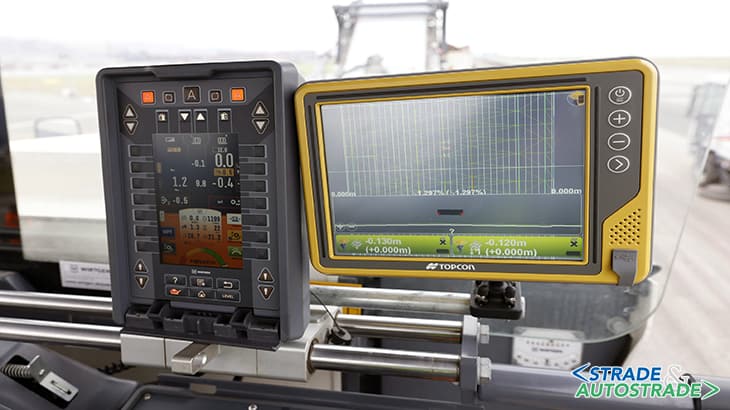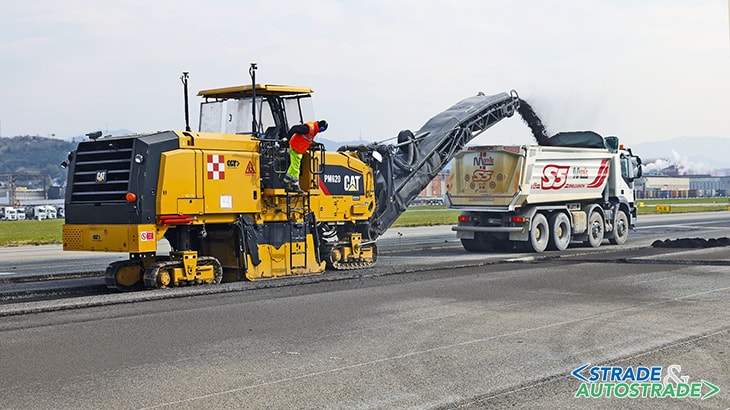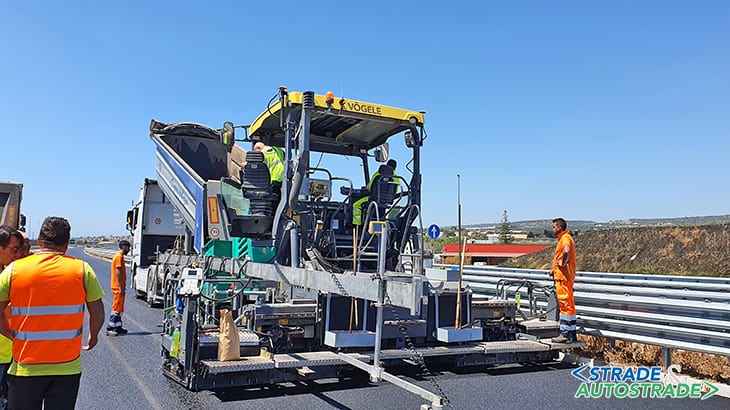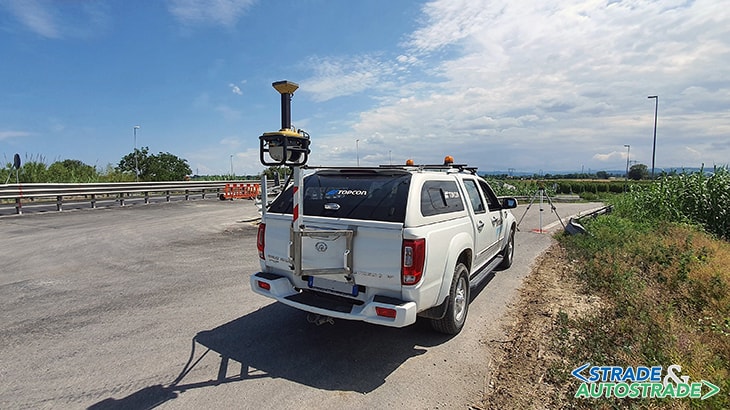![]() Per la versione in Italiano: https://www.stradeeautostrade.it/tecnologie-e-sistemi/come-digitalizzare-il-flusso-di-lavoro-delle-ripavimentazioni-stradali/
Per la versione in Italiano: https://www.stradeeautostrade.it/tecnologie-e-sistemi/come-digitalizzare-il-flusso-di-lavoro-delle-ripavimentazioni-stradali/
As the road construction industry continues to evolve, demand for quicker delivery and increased sustainability on projects puts heightened focus on the need for large-scale digital transformation. Topcon’s Experts listed five key reasons why contractors should consider digitalizing their paving workflows (https://www.topconpositioning.com/paving).
Maximizing efficiency in paving workflow
Short timeframes to complete work are especially common in paving. Many projects require full road closures, meaning that work must be carried out as quickly as possible to avoid extended disruption.
As a result, many teams are turning to the latest surveying tools, machine control systems and project management solutions to get the job done quicker, while improving quality.
GNSS is at the heart of this technology, not only offering teams on the ground a higher quantity of data but doing so in a shorter amount of time. In fact, by using such solutions, project teams can complete a detailed scan of a surface one day, getting an immediate picture of the surface condition, and start milling the next day.
The resurfacing software enables super-fast calculations for design work to be completed, which is exported directly to milling and paving control systems. What used to take weeks, even months, to complete can be done in a matter of days. At Topcon, our road resurfacing workflow is called SmoothRide.
It’s a comprehensive road resurfacing solution, encompassing scanning, design, milling and paving, and it delivers efficiencies every step of the way.

From vehicle-mounted scanners that capture thousands of datapoints per second, to automated milling machines and pavers that work simultaneously to the same design, SmoothRide can help complete traditionally time-consuming infrastructure projects in record speed and with the smoothest results.
SmoothRide makes it possible to prepare an accurate planning of the work, establish from the beginning the expectations and the consequent compliance with them, and above all the real results to be achieved.
Improving accuracy and consistency: the International Roughness Index (IRI)
Accuracy is key to the success of any paving project, and digital workflows ensure precision across the entire process, with each stage having a positive knock-on effect for the next. Scanners such as the RD-M1 gather such vast amounts of data that software can convert this into an exact digital, 3D replica of surface conditions.
This means that milling machines fitted with 3D machine control can follow the design precisely, automatically controlling depth to remove exactly the right amount of material from the surface, down to the millimetre, through variable thickness milling. This leaves a level, even base layer. And this is critical – an even base layer enables pavers to pave to a consistent thickness for a completely smooth, consistent result.

It doesn’t stop there. The finish is the most critical phase of a paving project, with time and temperature-sensitive materials like asphalt needing the utmost attention. Thermal mappers detect and report the already laid asphalt behind the screed and give the possibility to react on thermal segregation of the material.
Remote management platforms can assist the operator of the rollers, helping them to visualise their own passes and also the passes form other rollers on this jobsite to avoid over- and under-compaction. The result is a consistent, quality finish that will stand the test of time.
Saving money and materials
Time is money, especially in construction, so it goes without saying that by shrinking production schedules you can rack up huge savings in man hours. Aside from simply speeding up processes, one obvious way of reducing project timescales – or, more accurately, sticking to them in the first place – is by avoiding mistakes, and for all the reasons mentioned above paving technologies can achieve this.
Projects are delivered to design, to schedule and to budget. But the real savings are to be made when it comes to materials. Using resurfacing solution workflows, project teams can create multiple design scenarios based on the scan data to work out the most cost-effective.
The beauty of this is that only the amount of material that needs to be removed is removed, and then the minimum amount of new asphalt is produced and laid. Asphalt is incredibly expensive, particularly the top layer, so if you can reduce the amount needed by just one centimetre across a stretch of road, you can make hundreds of thousands in savings.
Workflows like SmoothRide created by Topcon are designed to assist every step of the way. With material wastage costing the road construction industry a fortune each year, such savings cannot be ignored and that’s not to mention the advantages for the environment.

Making jobsites safer
Safety is a paramount, and automation and digitalization can assist here, too. Scanning takes place from the safety of a car – important as roads remain operational – and with machines working automatically to precise designs, the opportunity for human error is reduced and fewer people are required on the jobsite. There are also no unnecessary materials kept on site, while logistic management solutions ensure that all stakeholders know precisely where materials and machines are in real time.
Connecting your workflow
The implementation of a fully connected workflow brings together the asphalt production process, logistics and paving at the jobsite for full visibility. It gathers and centralises all data, facilitating a connection between mixing plants and jobsites, meaning all relevant stakeholders understand the status of work in real time.
This is an important added value for all those involved: construction management, general contractor, but also third parties such as engineering offices engaged in the design and verification phases of the works; a virtuous circle that encourages and stimulates collaboration and integration of stakeholders.
From quantities of material and truck locations to screed width and paver speed, users can access data at the click of the button-data they need to make the right decisions, effectively manage their projects, and stay ahead of the game.

Tech adoption now for a prosperous future
The benefits brought about by embracing technological change are well documented across all sectors and the evidence is now plain to see in construction. There is a growing demand for global infrastructure – including renovating local roads and building new highways – and the only way we’ll meet such demands is by adopting streamlined, cost-effective and connected workflows now.
By saving costs on raw materials, reducing errors, and improving productivity, this technology has the potential to usher in a new era for construction, making infrastructure more durable and sustainable.
At Topcon, our paving systems enable digitalization of popular applications such as asphalt, concrete and curb and gutter work. Products such as Thermal Mapper and Intelligent Compaction help to avoid quality issues such as thermal segregation and over- and under-compaction.
Site management software such as Pavelink and Sitelink3D provide real-time visibility and reports, and finally an industry-leading workflow solution SmoothRide helps contractors to deliver consistent quality in any size of projects.
![]() Per la versione in Italiano: https://www.stradeeautostrade.it/tecnologie-e-sistemi/come-digitalizzare-il-flusso-di-lavoro-delle-ripavimentazioni-stradali/
Per la versione in Italiano: https://www.stradeeautostrade.it/tecnologie-e-sistemi/come-digitalizzare-il-flusso-di-lavoro-delle-ripavimentazioni-stradali/
